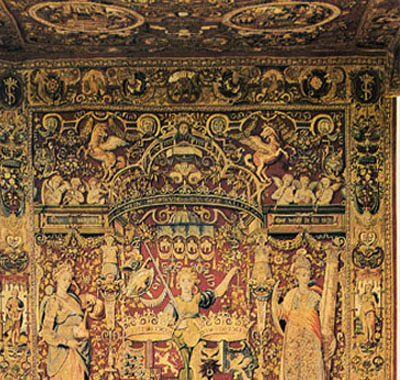| Udsmykningen

| | Frederik d. 2.s bordhimmel er et markant eksempel på den fyrstelige udsmykning. |
Et fyrsteligt slot som Kronborg krævede naturligvis kostbare udsmykninger af forskellig slags. Til at forestå dette blev der ansat internatinalt anerkendte kunstnere. Kronborgtapeterne, Frederik 2.s bordhimmel og Fontænen på slotspladsen blev pragtværker.
Kronborgtapeterne og Bordhimlen
Den store sal på det nyopførte Kronborg Slot blev udrustede med en suite tapeter/gobeliner, der forestillede (påståede) danske konger. Disse var komponerede af nederlænderen Hans Knieper. Han var oprindelig maler, men havde også en vis indsigt i tapetvæveriernes finesser og overvågede selv i Danmark arbejdets gang. Det drejede sig om en meget stor produktion, der talte 40 tapeter.
Fredrik 2. lod sin egen indsats forevige på den centrale gobelin i Hans Kniepers serie. Kungen selv er afbilledet i forgrunden sammen med sin søn(senere Christian 4.). Et par adelsmænd optræder i baggrunden. Man mener, at den ene af adelsmændene forestiller Tycho Brahe.Allerede i kontrakten med Knieper står der, at på den plads, hvor hans elskede Dronning skal stå "den daselbst sol ein Himmel mit dem Rückstück wie gebreuchlich auffgerichtett werden...". Kongetapeterne blev færdige i 1585 og samme efterår gik man i gang med kronen på værket, bordhimlen, som bærer årstallet 1586.
Bordhimlen blev udført med den allerstørste omhyggelighed og med rig anvendelse af guld- og silketråde udenom den dominerende silke. Den skiller sig afgørende ud fra kongetapeterne med disses grovere forarbejdning. I en nutidig svensk kunsthistorisk artikel kan man læse at den ”I sin velbevarede tilstand er et af hovedværkerne blandt de kunstskatte der befinder sig i Sverige". Grunden til at bordhimlen er så velbevaret er at den i mange år lå nedpakket, da man på grund at den udprægede danske heraldik ikke ville anvende den på noget kongeligt slot i Sverige.

Frederik 2. |
Analyse af Bordhimlen
Som helhed hænger himlens komposition sammen med de vævede tapeter, hvor det samlede udtryk præges af grotesker, en genre som blev mode ved femtenhundrede tallets midte. Kompositionen går hovedsaligt tilbage til Cornelis Floris, men i den kraftige tegning ser man også indflydelse fra Vredeman de Vries.
Rygstykket viser Frederik 2. og og hans hustru Sophie af Mecklenburgs våbenskjold. Bag våbenskjoldet står en kvindefigur, Justia, retfærdighedens gudinde, med vægtskål og sværd. På siderne står: Temperantia, mådeligheden, der blander vand i vinen og Fortitudo, styrken, med sin attribut kolonnen.
Kongeparrets våbenskjold og figurerne er indsat i en rigt udformet groteskkomposition. Over våbenskjoldene er der indsat en luftig gennembrudt baldakin, på hver side er der en slags bjælker med muciserende "putti". De tre store kvindefigurer står på et smalt postament. Nedenfor dette optræder to flodguder og diverse dyr.
Himlen har i midten det danske rigsvåben, omkranset af to putti, som flyver opad. Våbenet er omkranset af en slags "beslagværk" med fire runde medaljoner, der alle indeholder kongelige dyder. De områder af Himlen, der ikke er udfyldt af rigsvåbenet og medaljonerne er fyldt ud med groteskstilens typiske elementer: fantasidyr, figurer og blomster. I borden gentages groteskornamenterne og mellem dem, er der indsat heraldiske emblemer. Som en svenske kunsthistoriker understreger: "det hela är ett magnifikt uttryck for groteskstilen i dess nederländska form och rull- och beslagsverk".

Frederik 2.s bordhimmel | 
Bordhimmel | 
Bordhimmelen |
Fontænen på Kronborg
Allerede i begyndelsen af Kronborgbyggeriet (1576) bestilte Frederik.2, sandsynligvis på anbefaling af Tycho Brahe, en "vandkunst" hos den berømte bronzestøber G. Labenwolf i Nürnberg til Kronborgs store gårdsplads. I sin helhed er der tematisk tale om Hav og havdyr. En letfattelig allegori med Neptun (Frederik.2) på toppen af fontænen som havenes (Øresunds) behersker med den strømmende rigdom (Øresundstolden).
Der skulle dog gå syv år fra bestillingen til mesterværket under stor festivitas kunne indvies. Den lange leveringstid passede bestemt ikke Frederik.2, og de skriftlige kilder beretter om mange genvordigheder. Bl.a. blev figurfremstilleren truet af byrådet i Nürnberg med fængselsstraf, hvis han ikke opfyldte sine forpligtelser som "underleverandør". Årsagen til billedhuggerens problemer med dette antydes med at magistraten i Nürnberg i 1582 formente ham adgang til "alle kældre og værtshuse", mens færdiggørelsen fandt sted. Det hjalp. Fontænen blev leveret i 1583.

Fontænen | 
Fontænen i slotsgården |
Fontænens skæbne
Man kan desværre ikke se fontænen på Kronborgs slotsplads i dag. Under svenskekrigene i 1600-tallet blev fontænerne på både Kronborg og Frederiksborg Slot demonteret og ført til Stockholm som krigsbytte.
For Kronborgfontænens vedkommende troede man i mange år, at hele fontænen var støbt om, bl.a. til kirkeklokker, men nyere forskning har sandsynliggjort, at de tre gudindefigurer, på mirakuløs vis, har overlevet, og at de siden 1917 har kunnet beses på det svenske Nationalmuseum. Beviset for at det er de rigtige figurer skyldtes bl.a. at man fandt huller i figurernes brystvorter, hvorfra vandet i sin tid lystigt sprang og huller i bunden, hvortil vandet blev ledt ind. |